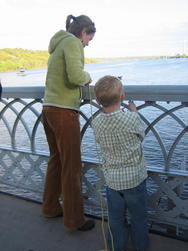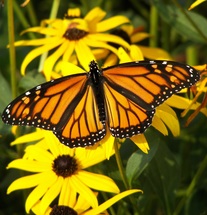 Meet Jim Christianson. When Jim first purchased a home on
Round Lake, he visited the Minnesota Pollution Control Agency (MPCA) to learn
more about the lake. During this visit 25 years ago, Jim heard about the MPCA's
water monitoring program and signed up to help. At 87 years old, he’s still at
it today!
Jim is part of a growing group of volunteers who observe and
record information about the natural world, in collaboration with professional
scientists.
Citizen science, also known
as crowdsourced science, volunteer monitoring, or networked science, is the
public involvement in inquiry and discovery of new scientific knowledge.
Typically, public involvement is in data collection, analysis, or reporting.
Citizen science programs are designed for people of all ages and
backgrounds and can be a great way to teach kids and adults about giving
back, taking care of the Earth, and paying attention to the world. Did you know that people who volunteer are generally happier and healthier, too?
We are inviting you to join a citizen science program. Yes, you can do this! Most programs have easy methods and
good training. A variety of programs are described below. When choosing a
program, consider the location—some can even be done in your yard—and frequency
of data collection.
|
 Not surprisingly, the “Land of 10,000 Lakes” provides many
water-related citizen science programs.
The MPCA’s own Citizen
Lake & Stream Monitoring Program involves 1,300 volunteers in water
clarity measurements. Tracking water clarity is like monitoring your blood
pressure—it can serve as a basic indicator of health. Identifying
changes in water clarity requires years of data, and wouldn’t be possible for
many Minnesota lakes and streams if it wasn’t for the monitoring efforts of citizen
scientists.
If you love water and weather, check out these programs:
|
 Tracking animals tells us about their migration patterns and
worldwide distribution. For example, in 1975, citizen scientists in Chaska
tagged a monarch butterfly that was eventually found overwintering in central
Mexico. This was the first conclusive proof that monarchs migrate thousands of
miles each year, and eventually led to habitat protection across their migration
route. Yeah, citizen science!
Tracking animal populations is also critical to their
protection. Through the MN DNR’s annual Frog and Toad Survey, citizen
observations have identified the endangered Blanchard’s cricket frog in Winona
County, and documented the devastating spread of bull frogs to new habitats in
the state.
If wildlife is your thing, here are some Minnesota programs to consider:
|
There are lots of upcoming events that let you participate, try-out, or witness citizen science in action. Here are just a few:
Come see the MPCA's new citizen science exhibit in the Eco
Experience building at the Minnesota State Fair. Stop by between 9 am and 9
pm, August 27 through September 7. There are also presentations by several programs--check out the stage
schedule for details.
Participate in monarch tagging at the U.S. Fish and Wildlife Service's Prairie Wetlands Learning Center, August 15 and 17,10 a.m.-3 p.m. (Fergus Falls). Folks closer to the Twin Cities can try tagging monarch butterflies at Maplewood Nature Center, August 29, 1-3 p.m. (Maplewood).
Visit Soudan Underground Mine State Park on August 15 for Science Saturday to learn all about the Monarch Watch program. Come back on Sunday for their River Canoe Trip: A Scientific Exploration of Water Quality to try your hand at testing water quality with the DNR during a naturalist-led canoe trip, August 16, 7:30 a.m.-1:30 p.m.
Visit Hawk Ridge Bird Observatory in September and October for some magnificent bird watching and naturalist programs. This nonprofit also runs the Hawk Ridge Western Great Lakes Owl Monitoring program. The University of Minnesota Raptor Center has a fall raptor release, September 26, 10 a.m.-3 p.m., Carpenter St. Croix Valley Nature Center (Hastings).
Thank you for reading Living
Green 365. This newsletter is a publication of the Minnesota Pollution Control
Agency. Please send questions or comments about living green to the address
below.
Sincerely,
Sam Burlager and the Living Green Team
livinggreen365.pca@state.mn.us
|